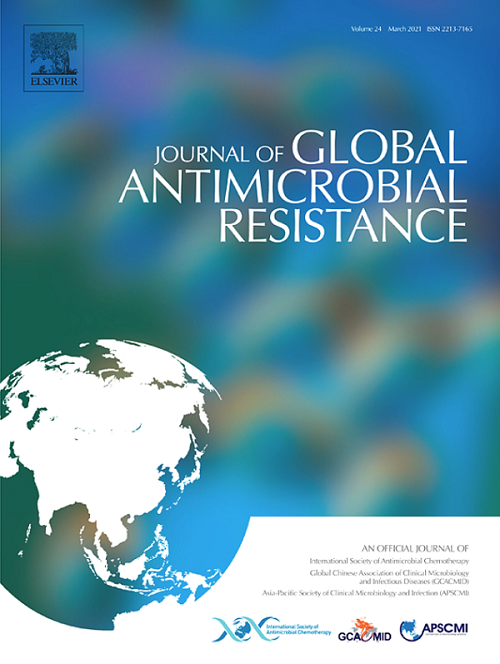Nationwide phylogenomic surveillance of Mycobacterium tuberculosis in Mexico reveals pathogenic and drug resistant signatures of the prevailing L4 sublineage
IF 3.7
3区 医学
Q2 INFECTIOUS DISEASES
引用次数: 0
Abstract
Background
Tuberculosis disease is a major global health concern. In Mexico, information regarding the genomic variants of Mycobacterium tuberculosis (MTB) prevailing in the country and the existence of specific biogeographical patterns remains extremely scarce.
Objective
This study aimed to identify the genotypic patterns of MTB isolates in Mexico and determine the genes and specific single nucleotide polymorphisms involved in the evolution of these populations.
Methods
Phylogenomic and pan-genomic analyses were performed using publicly available Mexican MTB genomes along with 33 newly sequenced genomes from Jalisco, considering a global context.
Results
The L4 sublineages of MTB, such as L4.1.1 (X), L4.1.2 (H), and L4.3 (LAM), were the most prevalent in Mexico. We found exclusive mutations and gene clusters in a virulent sublineage L4.1.1.3 (X3), which is endemic to Mexico. These genes encoded three PE/PPE family proteins: a multidrug transporter, thioredoxin domain-containing protein, quinone-dependent l-lactate dehydrogenase, DUF1725 domain-containing protein, amidase, poly (A) polymerase, and six hypothetical/uncharacterised proteins. Additionally, the genes encode an ESX-1 secretion-associated protein and a deazaflavin-dependent nitroreductase (ddn).
Conclusion
X3 was distinguished from the rest of the sublineages by containing genes related to pathogenicity and virulence, as well as a gene linked to delamanid, an antibiotic for active multidrug-resistant tuberculosis. These findings provide valuable insight into the circulation and spread of MTB in Mexico.
墨西哥结核分枝杆菌全国系统基因组监测揭示了流行的L4亚系的致病性和耐药特征。
背景:结核病是一个主要的全球健康问题。在墨西哥,关于该国流行的结核分枝杆菌(MTB)的基因组变异和特定生物地理模式的存在的信息仍然极其匮乏。目的:本研究旨在确定墨西哥结核分枝杆菌分离株的基因型模式,并确定这些群体进化中涉及的基因和特定的单核苷酸多态性。方法:考虑到全球背景,使用公开的墨西哥结核分枝杆菌基因组以及哈利斯科州33个新测序的基因组进行系统基因组学和泛基因组学分析。结果:墨西哥MTB以L4.1.1 (X)、L4.1.2 (H)、L4.3 (LAM)等L4亚型最为流行。我们在墨西哥特有的致命亚谱系L4.1.1.3 (X3)中发现了排他性突变和基因簇。这些基因编码三种PE/PPE家族蛋白:多药物转运蛋白、含硫氧还蛋白结构域蛋白、醌依赖的l -乳酸脱氢酶、DUF1725结构域蛋白、酰胺酶、聚(a)聚合酶和六种假设/未表征的蛋白。此外,这些基因编码ESX-1分泌相关蛋白和去氮黄素依赖的硝基还原酶(ddn)。结论:X3亚系与其他亚系的区别在于它含有与致病性和毒力相关的基因,以及与活动性耐多药结核病抗生素delamanid相关的基因。这些发现为了解MTB在墨西哥的传播和传播提供了有价值的见解。
本文章由计算机程序翻译,如有差异,请以英文原文为准。
求助全文
约1分钟内获得全文
求助全文
来源期刊

Journal of global antimicrobial resistance
INFECTIOUS DISEASES-PHARMACOLOGY & PHARMACY
CiteScore
8.70
自引率
2.20%
发文量
285
审稿时长
34 weeks
期刊介绍:
The Journal of Global Antimicrobial Resistance (JGAR) is a quarterly online journal run by an international Editorial Board that focuses on the global spread of antibiotic-resistant microbes.
JGAR is a dedicated journal for all professionals working in research, health care, the environment and animal infection control, aiming to track the resistance threat worldwide and provides a single voice devoted to antimicrobial resistance (AMR).
Featuring peer-reviewed and up to date research articles, reviews, short notes and hot topics JGAR covers the key topics related to antibacterial, antiviral, antifungal and antiparasitic resistance.
 求助内容:
求助内容: 应助结果提醒方式:
应助结果提醒方式:


